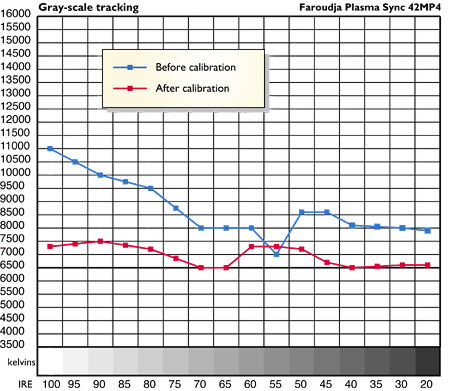Faroudja PlasmaSync 42MP4 & Native Rate Series Digital Cinema Source Plasma Display & DVD player-digital video processor Calibration

Faroudja sent my review unit after using it at several shows and demonstrations, so I make no claims for a new unit's condition "right out of the box." Still, the PlasmaSync 42MP4 arrived in better shape than most TVs I've seen, even if its picture was off-center: the left edge of the screen was blank, and some image was lost on the right. This was easily corrected.
The 42MP4's picture settings were closer to ideal than most televisions out of the box, possibly because this was a trade-show demo unit that had already been tweaked. Jamie Wilson, of Overture Audio/Video, calibrated it for me, but he discovered a disquieting anomaly: The color temperatures weren't stable. As he tried to adjust them to the NTSC standard of 6500 kelvins, the temperature on brighter images would not sit still, jumping around erratically through a range of about 1200K. The after-calibration numbers in the accompanying chart are thus approximations—Jamie picked a number midway in the range shown by the meter as the point darted up and down. When I asked Faroudja about this, they said they had never seen the problem before and could not immediately explain it.
The horizontal gray-scale pattern, which lines up bars horizontally with different brightness levels, from black to white, showed a different problem. Some of the bars were vaguely colored—reddish, greenish, bluish. The perplexing fact was that the next pattern showed the same bars stacked vertically, with none of the colorations seen in the previous pattern. This coloration did not seem to present any sort of visible problem in regular program material. At the same time, the jumping color temperature was not at all visible on the test pattern, even as we watched it on the color-analyzer display.
This illustrates an important point. For years, the Image Science Foundation and other video gurus have pushed the notion that, to look its best, a display device should present a color temperature of D6500 across the board, from the brightest images to the darkest. In truth, a TV set at 7500K or even sometimes higher can look identical to one at D6500; even expert viewers can't tell the difference, as we found in this case. That's why it often makes little sense to pay someone to calibrate your set if it comes with the ability to display a picture close to the NTSC standard. As Wilson put it, "Some of the worst-testing sets look beautiful."—JB
I beg to differ with the opinion in the last paragraph. Very few televisions are set up to properly reproduce a gray scale out of the box. While they may measure reasonably well at one or two points, they will for the most part "track" poorly; that is, at different brightness levels the color temperature will change. Linear tracking of the gray-scale from black to peak white is just as important, or perhaps even more so, than the color temperature number itself. A set that tracks well across the brightness range but measures 7500K everywhere may well look better than a set that hits D6500 at a few points but wanders from 5500K to 7500K everywhere else.
A beautiful-looking set is not the goal. If you want to see what the program is supposed to look like, the set must be accurately calibrated, with the right gray-scale good tracking, the proper color points, and a myriad of other requirements. It's then up to the program material to look beautiful—or not, depending on the program producer's intent. But, as stated differently elsewhere in this issue, we can agree that there are some important picture characteristics that we cannot yet measure, and some picture flaws to which the eye is not sensitive. And since no one has yet built the perfect television or video projector, how well the designer has chosen his or her compromises will be a major factor in the quality of the result.—TJN
- Log in or register to post comments














































